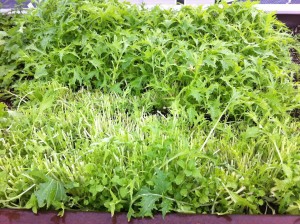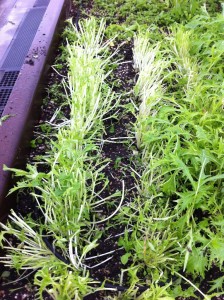In a culture that glorifies individual achievement and coming out on top, second can often be interpreted as “first loser”. But I’m here to say that at least regarding mustard greens, second is just as good as, if not better than, first. I’m not making any claim to having invented a new technique. I’ve been reading about “cut and come again” for as long as I’ve been gardening. It all makes perfect sense. Why pull out a crop after harvest if just by leaving it there it will produce again and again?
What I’ve found, however, is that regrowth from a dense planting, such as tightly spaced baby lettuce or mustards, will often be lower quality, as all those crammed plants, having spent themselves on their initial leafy outpouring, will start bickering and fighting over limited resources. Well, let’s just say that things, including how the plants look, can get ugly.
We plant our greens tight at the Noble Rot, and we take them small, before serious root competition ensues. If we’re going to get a second cut, it has to meet our quality standards, so I’ve been working on a way to ensure that. Tightly-planted, lightly-rooted mustard greens, like the Mizuna mustard you see below, offer little resistance to being tugged out, so after our first cut I take out every other row.
 |
| Mizuna mustard. Background is secondary re-growth, and foreground is just cut first growth. |
If I follow that thinning with a little fortified drink of liquid fish and kelp, then I’ve found that it’s a slam dunk to get great-looking, second-round greens. Additionally, the stress of a thorough hair cut can induce the plants to make more finely cut leaves, upping the visual value of the product (See my April 2013 posting, “Consummate Shape Shifters”).
So we can all take heart, and we can take those cultural messages with a grain of salt. First is not necessarily best.

